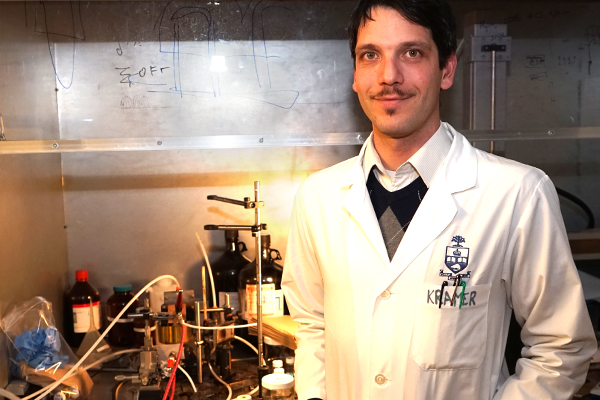It may look more like Junk Yard Wars than high-tech, but U of T researcher Illan Kramer’s (pictured below) device is the first step towards spray-on solar cells.
That’s Illan Kramer’s (ECE) hope. Kramer and colleagues have just invented a new way to spray solar cells onto flexible surfaces using miniscule light-sensitive materials known as colloidal quantum dots (CQDs)—a major step toward making spray-on solar cells easy and cheap to manufacture.
“My dream is that one day you’ll have two technicians with Ghostbusters backpacks come to your house and spray your roof,” said Kramer, a post-doctoral fellow with The Edward S. Rogers Sr. Department of Electrical & Computer Engineering at the University of Toronto and IBM Canada’s Research and Development Centre.
Solar-sensitive CQDs printed onto a flexible film could be used to coat all kinds of weirdly shaped surfaces, from patio furniture to an airplane’s wing. A surface the size of your car’s roof wrapped with CQD-coated film would produce enough energy to power three 100-Watt light bulbs—or 24 compact fluorescents.
He calls his system sprayLD, a play on the manufacturing process called ALD, short for atomic layer deposition, in which materials are laid down on a surface one atom-thickness at a time.
Until now, it was only possible to incorporate light-sensitive CQDs onto surfaces through batch processing—an inefficient, slow and expensive assembly-line approach to chemical coating. SprayLD blasts a liquid containing CQDs directly onto flexible surfaces, such as film or plastic, like printing a newspaper by applying ink onto a roll of paper. This roll-to-roll coating method makes incorporating solar cells into existing manufacturing processes much simpler. In two recent papers in the journals Advanced Materials and Applied Physics Letters, Kramer showed that the sprayLD method can be used on flexible materials without any major loss in solar-cell efficiency.
Kramer built his sprayLD device using parts that are readily available and rather affordable—he sourced a spray nozzle used in steel mills to cool steel with a fine mist of water, and a few regular air brushes from an art store.
“This is something you can build in a Junkyard Wars fashion, which is basically how we did it,” said Kramer. “We think of this as a no-compromise solution for shifting from batch processing to roll-to-roll.”
“As quantum dot solar technology advances rapidly in performance, it’s important to determine how to scale them and make this new class of solar technologies manufacturable,” said Professor Ted Sargent (ECE), vice dean, research in the Faculty of Applied Science & Engineering at University of Toronto and Kramer’s supervisor. “We were thrilled when this attractively manufacturable spray-coating process also led to superior performance devices showing improved control and purity.”
In a third paper in the journal ACS Nano, Kramer and his colleagues used IBM’s BlueGeneQ supercomputer to model how and why the sprayed CQDs perform just as well as—and in some cases better than—their batch-processed counterparts. This work was supported by the IBM Canada Research and Development Centre, and by King Abdullah University of Science and Technology.
Publication References:
Illan J. Kramer, James C. Minor, Gabriel Moreno-Bautista, Lisa Rollny, Pongsakorn Kanjanaboos, Damir Kopilovic, Susanna M. Thon, Graham H. Carey, Kang Wei Chou, David Zhitomirsky, Aram Amassian, Edward H. Sargent. Efficient Spray-Coated Colloidal Quantum Dot Solar Cells. Advanced Materials, 2014.
Illan J. Kramer, Gabriel Moreno-Bautista, James C. Minor, Damir Kopilovic, Edward H. Sargent. Colloidal quantum dot solar cells on curved and flexible substrates. Applied Physics Letters, 2014.
Graham H. Carey, Illan J. Kramer, Pongsakorn Kanjanaboos, Gabriel Moreno-Bautista, Oleksandr Voznyy, Lisa Rollny, Joel A. Tang, Sjoerd Hoogland, Edward H. Sargent. Electronically Active Impurities in Colloidal Quantum Dot Solids. ACS Nano, 2014.
Article Source:
New technique offers spray-on solar power; University of Toronto Faculty of Applied Science & Engineering — December 5, 2014












Comments